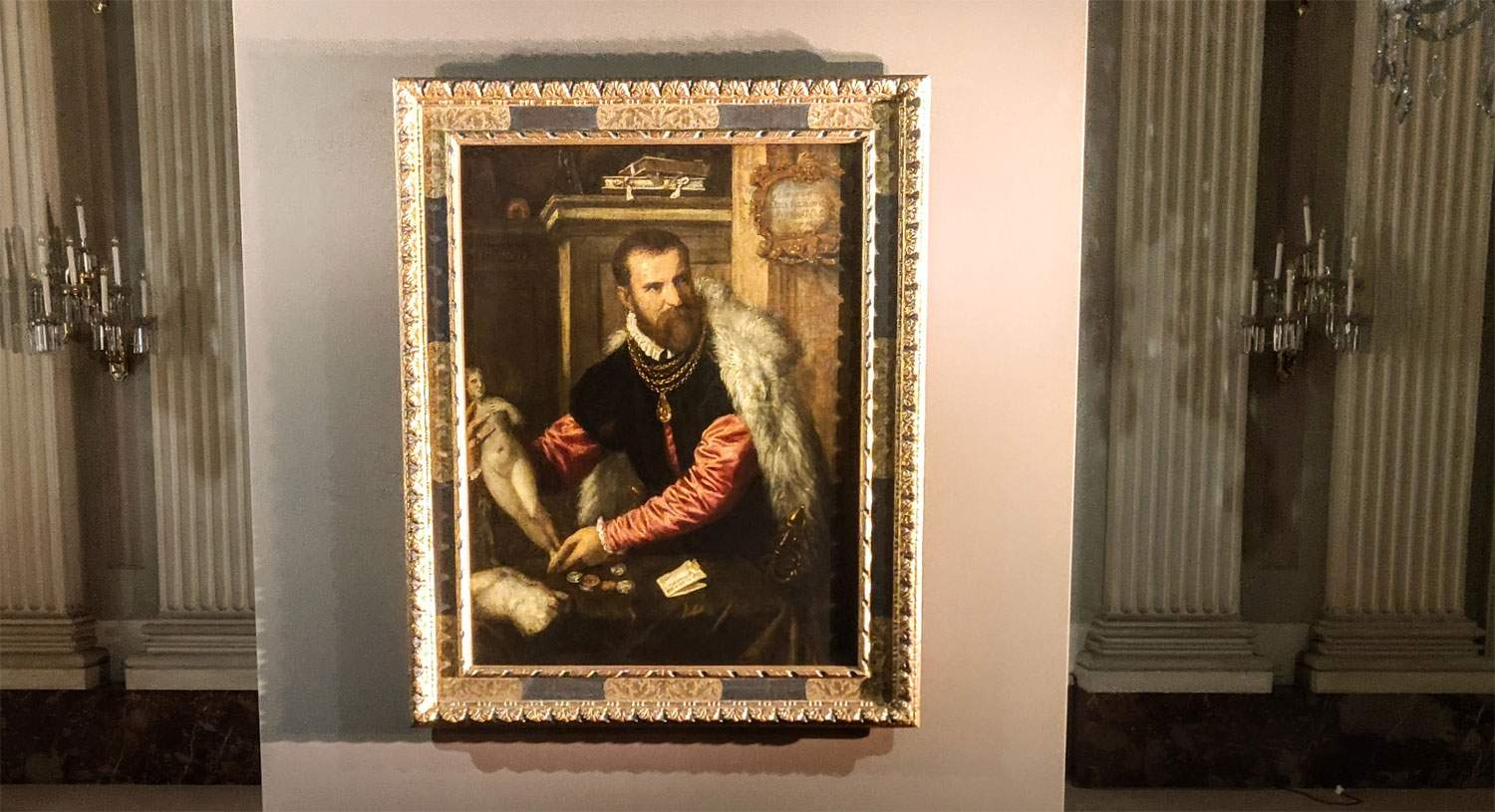A welcome guest at the Pitti Palace: in fact, one of Titian Vecellio ’s (Pieve di Cadore, c. 1490-Venice, 1576) greatest masterpieces, the Portrait of Jacopo Strada, one of the Cadore painter’s most famous works, arrives in Florence on loan from the Kunsthistorisches Museum in Vienna from October 5 until January 16, 2022. The painting is on display in a small focus exhibition entitled A Guest from Vienna. Titian’s Jacopo Strada, which features him along with a small antique Venus carved in marble, similar to the one Strada holds in his hands in the painting. It is a small work but one with a long and prestigious collecting history, as archival papers testify to its presence on the boxes of the Uffizi Tribune from at least the early 18th century. However, of antiquity the figure retains only the torso with the upper part of the legs: the fragment was in fact skillfully integrated by a 16th-century sculptor who gave life to an image of the goddess Aphrodite with, in her left hand, the apple she is imagined to have just received from Paris.
Held since the 17th century in the art collections of the Habsburgs in Brussels and then Vienna and now among the masterpieces of the Kunsthistorisches Museum in the Austrian capital, Titian’s work depicts the antiquarian, architect, goldsmith, writer, collector and art dealer Jacopo Strada (Mantua, c. 1515 - Vienna, 1588), one of the most culturally energetic and multifaceted figures in 16th-century Europe. Born into a noble Mantuan family, he trained in humanistic studies within the refined cultural circle gathered around the Gonzaga court. In 1546 he moved to Germany, where he began a fruitful activity as art adviser to the leading collectors of the time, including the very powerful banker Jakob Fugger, Emperor Ferdinand I of Habsburg and Duke Albert V of Bavaria. His numerous trips to Italy in search of antique sculptures, medals, drawings and paintings by the major Renaissance masters led him particularly to Rome and Venice, where in 1567 he tried in vain to acquire the collection of Senator Gabriele Vendramin, a friend and patron of Titian. It was on this occasion that he met Titian and created the painting now on display in the White Room at the Pitti Palace.
The Viennese painting is one of the last portraits executed by Titian, who had long since abandoned this pictorial genre in which he had also given lofty proofs, many of which can be admired in Palazzo Pitti itself, in the rooms of the Galleria Palatina, and also in the Uffizi. Titian succeeded in interpreting the personality of the protagonist in an original way, forgoing posing him and choosing instead to represent a fragment of his life. In the foreground, very elegant in his red suit complemented by the black velvet farsetto, gold chain, sword, and fur coat resting carelessly on his shoulder, Jacopo has just bent to lift a statuette of Venus from the table on which other ancient artifacts are resting: a torso, a bronze statue, and coins of Roman emperors. With a jerk, he turns his head to the right, directing a determined gaze at interlocutors outside the scene, and Titian makes us feel all the vitality of that movement, both in the juxtaposition between his arms and face and in the lightning intensity of his blue eyes. Many other precious objects, carefully arranged in the small room, contribute to defining an ideal and celebratory setting for the wealthy antiquarian: books, a bronze statue of Hercules, a pomegranate tree, the sumptuous cartouche with the Latin inscription in which Strada is referred to as civis romanus (a title bestowed on him by the pope in 1555) and imperial “antiquarian.” Finally, the relationship with the Venetian painter, who was probably also a business understanding, is reiterated in the header of the letter in the foreground, on which it reads “al Mag(nifico) Sig (nore) il Sig (nor) Tit (iano) Vec (ellio).”
“With the exhibition of the portrait of Jacopo Strada, one of Titian’s most famous masterpieces, here contextualized with two works from our collection to testify to the mania for the antique in the 16th century,” says Eike Schmidt, director of the Uffizi, “the fall season of exhibition events at the Uffizi Galleries opens with a bang. The coming months will see the addition of exhibitions ranging from childhood in ancient Rome to contemporary art, from the earliest pictorial depiction of Dante’s Count Ugolino to efforts against violence against women.” Kunsthistorisches Museum Wien director Sabine Haag emphasizes, “I am sure that this wonderful painting will stimulate interesting discussions and entertain Uffizi guests in the coming months.”
Image: Titian, Portrait of Jacopo Strada (1566; oil on canvas, 123 x 95 cm; Vienna, Kunsthistorisches Museum, Gemäldegalerie)
 |
| A guest at the Pitti Palace: from Vienna comes Titian's Portrait of Jacopo Strada |
Warning: the translation into English of the original Italian article was created using automatic tools. We undertake to review all articles, but we do not guarantee the total absence of inaccuracies in the translation due to the program. You can find the original by clicking on the ITA button. If you find any mistake,please contact us.